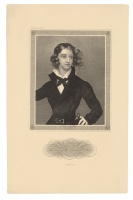
Emilia Plater
| Author: |
Carl Mayer (1798–1868) |
| Created: | 1840 |
| Material: | paper |
| Technique: | steel engraving |
| Dimensions: | 24.30 × 15.50 cm |
| Signature: | top: Ms Conv. I ex No 149 bottom: Stahlstick von Carl Mayer and Inst. Bibl. exc.t inscription: Grafin / Emilie Plater |
MEYERS KONVERSATIONS-LEXIKON, XIX A.
In the 19th century in Lithuania, imaginary portraits were published of famous women from the past, primarily from among the nobility. Along with Queen Jadvyga, Barbara Radziwiłł and Katarzyna Jagiellonka, engravings appeared of Birutė, Grand Duke Kęstutis’ wife. Portraits of contemporaries were also reproduced. Pictures of Emilia Plater, a participant in the 1831 uprising, were particularly popular in Lithuania. Lithographs of her aide-de-camp Maria Raszanowicz, based on the picture by Achille del Devéria, were popular too. The names and faces of these women were associated with the hope for freedom, and symbolised idealistic self-sacrifice for the good of the homeland. Plater’s significance in the history of modern Poland is shown by her picture on the 20-zloty banknotes issued in the interwar period. In Lithuania in 2006, to commemorate the brave fighter against the occupiers, and to mark the 200th anniversary of her birth, the Bank of Lithuania issued 50-litas commemorative coins with a prototype of a semi-figurative portrait of the rebel on the reverse (based on the engraving by Carl Mayer).
Text author Giedrė Jankevičiūtė.
Source: Law firm Valiunas Ellex art album MORE THAN JUST BEAUTY (2012). Compiler and author Giedrė Jankevičiūtė, RES PUBLICA (2018). Compiler and author Rūta Janonienė






